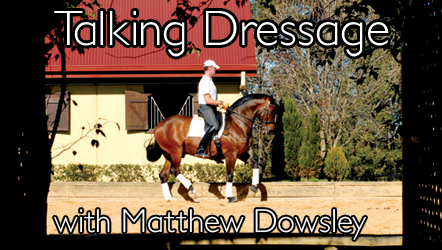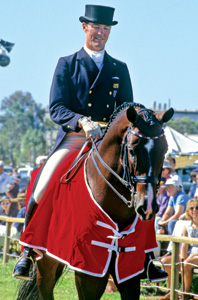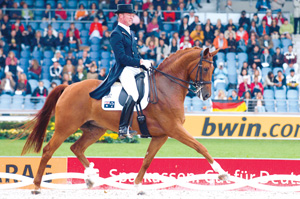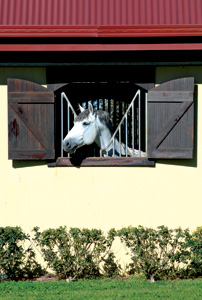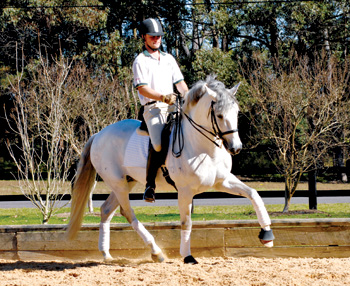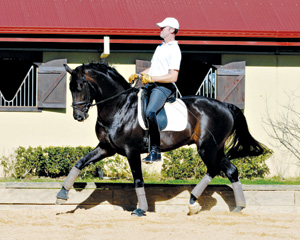For most spectators there’s a moment in time when a rider passes by and grasps your full attention. It may be the straightness of their back, the softness of their hands or the seemingly easy way they sit to an elevated extension. One rider who possess all of these traits is Matthew Dowsley and I can only wonder how many riders he’s inspired to pursue Dressage in the hope they could one day achieve similar heights.
Matthew’s interest in horses was sparked early in life by growing up at his parents riding school in the Blue Mountains. Beginning as a five year old he helped with many of the 37 horses: “We jumped and barrel raced. It was fun and a great way to start riding. We had five kids in our family. They were probably a bit more talented than me, but I stuck with it.”
By the time Matthew was 14 he knew Dressage was for him: “I started doing some gymkhana and jumping events. Then I saw Dressage in the magazines and it was pretty small here then. But I saw Judy Dierks riding around and it was so elegant and I thought, I want to do that. And you can always learn more, everyday you learn something.”
Despite his parents being in the horse business they were never competitive riders themselves: “They’re really proud of what I’ve done, but I think they see how much work I put into it, so they kind of expected me to be successful in the sport.”
Together the family also ran a hairdressing business that imported and exported salon equipment: “My elder brothers and sister were right into that, but I was always just obsessed with the horses.”
Matthew formed the foundations of his training with Judy and Clemens Dierks where he rode for a few years from the age of 16. It wasn’t until 1997 that he was given the opportunity to train in Germany: “I’d been to buy horses there but my first riding experience was when I went over with Argentille Gullit.”
Gullit was purchased by Brian Silvia of Val D’Argent Warmblood Stud as a three year old colt from The Netherlands. The Dierks helped Matthew produce the horse and he went on to win State and National titles from novice through to Grand Prix. They were then selected to train and compete in Europe for three months. The start of his European tour saw Matthew train with the late Herbert Rehbein: “I was really lucky to be given that opportunity just before he died. He didn’t speak a lot of English but what he did say I really learnt a lot from and watching the good riders. Just seeing the difference in what they ask of the horses, you don’t see that here. It was a great experience.” It was at this stable that Matthew saw legendary horses such as Donnerhall and Walk on Top being trained on a daily basis.
Despite many riders having their share of nightmarish tales from foreign training barns, Matthew didn’t find his first German experience daunting: “You just feel like you’re in your element because you’ve worked the whole time towards that and then when you get given that opportunity it’s just fabulous. I never went overseas and just worked. I was always under the impression that you make horses a little bit here in Australia, and then when you go over there with a horse you learn a lot more.”
Although many young riders go to Germany to work, Matthew believes going over to campaign a horse provides a more valuable learning experience: “I think it’s totally different to my generation, we all banged around here and made the horses and then we’d go over there for the competitions. But I think now the next generation is different. I’ve had a few kids here that showed a bit of talent and they’ve gone, straight to Europe. They haven’t even got a horse. I think gee they’re game, but people grow up a lot quicker these days. I wouldn’t have had the confidence to do that. It’s good if they can stick it out and they find a good trainer who can help them. But they’ve got to work. It’s not like here where you slop around and do a few stables, you’ve got to work a lot harder. It is good though, it’s good to be where the sport is. You know, here it’s nice and it’s a lovely pastime but they’re very serious.”
In 1998 Matthew and Gullit were selected to tour Germany again, this time vying for selection for the World Equestrian Games in Rome. Unfortunately they were named as the reserve combination for the WEG team. Gullit was sold soon after to a client of Carl Hester’s and then represented Great Britain at the Sydney 2000 Olympics.
Cinderella began the next chapter in Matthew’s riding career and is still remembered as Australia’s favourite Dressage mare. Purchased by Claudia Harper in 2000 from the Hanoverian Elite Auction in Verden and eventually campaigned by Matthew. Due to her fiery nature, the combination made an impression on Dressage enthusiasts all over the world: “She had such, not just expression, but personality. She was a naughty little thing and we trained her here and Bimbo used to say to me, ‘I don’t understand why you don’t win everything with that horse.’ And I said, ‘Well she’s a little bit different when you take her to a competition.’”
“At the beginning she was tricky to train but once she got the general idea of what we wanted when she was coming towards Prix St George she was great. She knew the Grand Prix work basically then. But if it didn’t suit her then she didn’t want to do it on the day. She’d squeal and run away and pig root and leap through the air. I used to say this to Ulla and she said, ‘Well you must get really nervous.’ And I said, ‘Well I do because I know what’s going to happen!’ But she said, ‘Just get on with it, go to the competition and ride her like you do at home.’ And then she saw and she said, ‘Oh my god she is difficult isn’t she’. Then we started to put the pressure on each day in the training for the competitions. We’d train her and then do some test movements and then rode the test everyday until I think she just got a bit sick of being naughty.”
The sad end that came to Cinderella’s dressage career has been well documented. She was humanely put down in July 2007 after the tumor vets hoped to have removed from her right eye continued to grow and spread. But Matthew no longer wonders what could have been: “I mean you can look into it like that, but then also I’ve had a lot of talented horses that haven’t gotten half way up the levels. You can always sit back and wonder, but I just think how many people had an opportunity to do what I got to do with that horse? And it was just lucky you know the owner just loved the sport, loved the horse. I remember her saying to me, ‘If that horse gets to Grand Prix I’ll send you to Germany’. And I said, ‘Can’t we go now’ She said, ‘No if it gets to Grand Prix we’ll go’ and she stuck to the bargain and it was wonderful.”
Matthew still hasn’t come across a horse to fill Cinderella’s shoes: “It’s hard to compare any horse to one you’ve done something like that on. I mean, it was a fairy tale. We went to competitions in Europe and I remember being at a competition in Austria when the crowd screamed and yelled after my Kur. She was winning and my partner Rodney and I just looked at each other and went, ‘They must think we’re Austrian not Australian’. But they really embraced us and I’d think how can someone do that from so far away? She was winning with 73% or something and I was just elated. But there were about two horses to go and then up in the secretary’s office they were all panicking because they didn’t have an Australian anthem! And I thought don’t put on God Save the Queen ’cause that’s not our bloody anthem. In the end a Russian girl beat me, but it was still fabulous. In Germany too they were really good. If they see you really trying and you get some good work and if you do the right thing by them, they hold you in high regard. Because they all know how hard it is.”
Matthew cites his time in Europe with Cinderella as the most influential period in his Dressage career: “Claudia was good enough to give me the opportunity to train with Siegfried ‘Bimbo’ Peilicke and it really helped me produce Cinderella here. But then the intense training I had with Ulla, every day, was just fabulous. It was just the best thing I’ve ever done in my life. Sometimes it was a little bit hard but you learn and you get through it.”
Currently based in South Maroota on 25 acres Matthew is looking to relocate closer to Sydney and onto a smaller property. It’s here Matthew is able to indulge his two loves of the sport – training and coaching: “I love training the horses everyday, just chipping away at it. Even now just coming out every morning and helping Rodney we just gradually bring the horses along from three year olds and take them up to the higher levels. It’s lovely to see them be produced. Sure you have bad days but you get through it.”
Matthew is 44 years old now and is the first to admit his routine isn’t as strict as it once was: “I come out…a lot later than the others”, he laughs. “I say I’m old now, I’ve done my time, I’m not getting out here at 7 in the morning anymore. Rodney starts at some ungodly hour, like 6.30 riding horses before he goes to work. I’ll come out at 8 at the earliest, but not very often. Sometimes I eat breakfast out here and help Rodney, then I’ll ride a few and then teach a little bit. I usually finish the horse work by 2 o’clock, then I have a break and then sometimes I might teach after that.”
One rider who demonstrates the benefits of Matthew’s training is his partner Rodney Martin, a former hack rider who is now one of the most competitive dressage riders in Australia: “I teach Rodney everyday, he has to put up with it. He used to yell and scream at me, but now he’s got a very nice young horse, Falstermeyer, we bought him as a baby when I bought San Jose and he’s doing very well. He’s a six year old gelding, and he’s a very big horse, he’s nearly 18 hands and we’ve taken our time with him so he’s just done exceptionally well. He’s got over 70% scores in novice and now we’ll start some elementary to see if we can get him into Nationals for both levels. Then we’ve got to compete against each other though, which is a shame.”
A new face at the Dowsley barn is 25 year old Brett Davey. Brett is an accomplished Dressage rider but has since joined the eventing circuit with much success: “Brett just rides a few horses then he goes off and rides some for other people. He’s the first rider I’ve had working for me here, but I did have a very good German boy, Andreas Schoeffner, for a while, who was a very good friend of ours, but I was a bit spoilt with him. He was a bereiter so he helped me and gave me lessons. He knew a little bit with the piaffe, passage and he did his training with Wolfram Wittig who trains Isabell (Werth). We used to work together a little bit in Europe and he became such a good friend he would come over for holidays, and then he wanted to come out for a few months this year. He helped me and then he left and I thought, ‘look at all these horses, I can’t ride them all’ and Brett was looking for work, so I thought well we’ll try this. But I usually ride five, Brett will ride three or four and Rodney rides a few. We have 12 horses in full work at the moment.”
In the backround of my interview with Matthew was Brett riding the 13 year old Lusitano Stallion, Que Craque. ‘Q.C’ has been at Matthews for a few months and is owned by Katharine Howard-Olsen. Matthew kept an eye on Brett and provided some valuable insights into his training: “Ride him a little bit more forward, you can think a little bit cadence but not too slow. He’s got to come more from behind and more over the back. When he blocks against your hand, flex him and push him through with your inside leg. Now get his neck higher, the higher he sits up and the lower the hind legs come under, the more you bring him into collection. He can’t go around hanging down, he’s got to start carrying himself and that’s where you ride forward and back so many times.”
Matthew informs me: “Usually I ride this horse but it’s good for Brett to feel, and it’s good for the horse to have someone different on him. That way there’s not so much pressure on them everyday.”
This stallion looks like a mirage that’s been conjured straight from a fairy tale and with a talented rider like Brett in the saddle, showcasing this horse’s beautiful freedom in the shoulder, I found it difficult to concentrate on questioning Matthew. I quickly recovered and enquired about Matthew’s enjoyment of teaching: “I’ve been coaching for years and I do enjoy helping people more when the horses live here, because I get to see them more often. Brett only started yesterday, but he’s got a really good feel and he’s already riding better today. But then you’ve got the girls who, which fair enough they can’t afford it, only come once a week. In Europe it’s not like that. You go somewhere and you train everyday, or someone oversees you so you don’t get into a bad habit. That’s a great way to do it. Here it’s hard we’ve got all these big distances to cover and someone will get a lesson once a week, or once a fortnight, and half the lesson you’re just correcting what you corrected the week before.”
We’re seamlessly interrupted again with more words of wisdom from Matthew imparted onto Brett: “To get him to the next step in his collection, you’ve got to get the feeling from medium trot, and then into a passage that he closes more and keeps the same tempo. When you make the contact secure, it’s easier for him. You have to keep the contact and push him uphill. You give when you have a good feeling, not when everything’s going wrong. If you have no contact, you have no communication.”
This led us to discuss the common problem Matthew finds when training riders: “Just basic throughness. They make them round, but there’s a long, long way from the head to the hind legs. People have got to remember that a Dressage horse is ridden from the hind legs. You know, you don’t need the best moving horse, if you ride it well, and it accepts the training, and it’s sound enough, you can make something pretty extravagant.”
Matthew reflects on the trend to purchase horses with off-the-ground movement: “Some of the big moving horses are really hard to collect. The more normal moving ones are usually a little naturally quicker in the hind legs, which is good. Sometimes the ones with the extravagant movement, the more you close them the slower they get, they’re harder to put together.”
The rhythm of Matthew’s horses is often admired and considered the standout trait of his training: “I like them to swing which Bimbo really instilled in me, you just didn’t go more than 10 metres without making a transition within the pace. You don’t just swan around like a washing machine. You’ve got to keep making differences and that’s how you develop the way they move. When they’re on the hind legs that much, they go forwards, they come back, they go left, they go right and its easy then. You teach them to go through the body and then they’re like rubber. As long as when you ask them to collect they understand the hind legs keep going, a lot of people don’t understand that. They think collection means go slow but the hind legs must be active.”
It’s inspiring watching Matthew ride and when he marches his five year old stallion, San Jose, into the arena I know it’s going to be good: “I bought him as a two year old and his mother is a Rubinstein/Weltmeyer mare bred by Silvia Johannsen in Germany, who’s a very dear friend of mine. He’s competing novice/elementary averaging a 75% in novice and he scored 75% in his first elementary.”
Matthew begins all his training sessions with a lot of walking: “They’re stabled so much, so I really like to walk them a lot before I start, and do a little renvers and travers before I trot.”
It’s hard to find a weakness in any of San Jose’s paces; he has a huge over-track in walk, a ground covering suspended trot and an uphill engaged canter: “I only got him because he didn’t trot like this in Germany. Silvia told me when he was going into quarantine the vet looked at the horse and the papers with his breeding and couldn’t believe we were sending him to Australia. She said he should be kept in Germany for the Stallion licensing.”
Next into the arena was Broadstone Dramatik, owned by Freida Macklin and Roz Tippet from Perth. He was originally purchased in the UK and is now an 11 year old small tour horse. Broadstone Dramatik has been at Matthew’s for almost a year working toward the Grand Prix with Roz flying over once a month for a lesson.
Matthew starts riding in walk with different suppling exercises, travers, shoulder-in, then straight into a collected frame. This horse has a powerful build and a nice rhythmical trot. He rides shoulder fore in canter with lots of walk breaks: “How you begin depends on the horse, they will always tell you. If they want to throw their heads down low then I’ll keep them up, but if they want to hold themselves up then I’ll take them down low.”
Although the horse begins with a somewhat ordinary trot, he’s soon flicking his legs in the air as good as the next import. When Matthew picks him up he moves into another gear and the work is uphill with a lovely suspension. Constantly Matthew asks the horses for more and never accepts less than what he knows the horse can give.
Seeing Matthew cruise through the FEI work it’s easy to see where his competition preference lies: “I love the young horse shows, but it’s not the be-all-and-end-all for me. I mean, you can crank your horse up so many gears, but then usually you don’t have anything left when it gets to the higher levels. I think it’s nice here because they don’t wind them up so much. The young horse shows are usually quite glamorous and the owners get to see their horse doing something quite nice. The show in Melbourne is run fabulously and the CDI young horse shows are great fun, but you know it’s not my thing. I love bringing on the young ones and I love training them and showing them, but more I like to bring on the higher level ones. I’d like to get another horse to a high level, but I’m fussy. I don’t want to go there with a normal one. I’d like something that you really can work with and make it into something that they’ll give you the marks for. Because it’s hard, there’s no point going if you’re only going to get 62 or 64%, that’s nothing in Europe, there’s a million of those.”
The best thing about dressage is you can never be too old, well at some point you will be, but considering 67 year old Japanese rider, Hiroshi Hoketsu, made the last Olympics I think Matthew still has a couple of decades to find another Cinderella.

